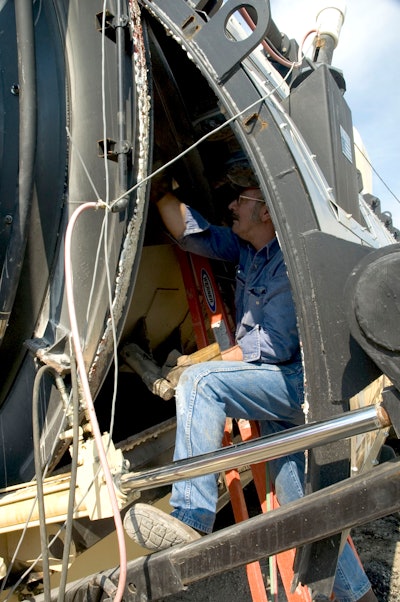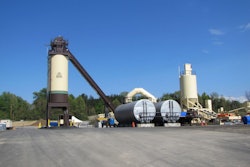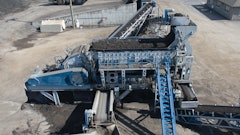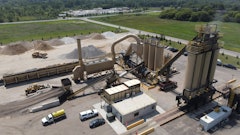
When asphalt contractors are ready to pave, your plant better be ready to work. Unexpected downtime during the paving season is costly not only to your plant operations, but often times for your customers as well. With spring just around the corner, operators should be focused on making sure their facilities are in top operating shape before it’s too late and production is stalled.
"The spring time is the busiest time for the service department. Plants do not like to be shut down, not even for one night, and when they are down for months it is even worse," says Mike McClure, regional sales manager, parts department at Astec. "Just like on a daily basis the morning is when you are more likely to have a break down, the spring startup is your most troublesome time of the year."
Asphalt plant manufacturers know their products and can offer insight into what you should address before the season begins.
Prevention is Key
During the winter months, your company should have been optimizing plant downtime by completing a myriad of preventative maintenance tasks. A winter repair regimen for asphalt plants consists of a list of 'trouble spots' that have accumulated over the course of the season that they know need to be addressed in the off-season. During this time, be sure to thoroughly check things that are often overlooked when they've been trouble-free.
"Every plant should have a checklist for their particular plant for getting ready for storage and the spring startup," McClure says. "Have the list sitting in sight in the control house for several weeks before you shut down and when you see something that needs attention over the winter, put it on the list. Then prioritize the items. During the winter maintenance make sure everything is done, especially the things that had high priority."
“Proper plant maintenance is a good investment for long term plant operation,” says Mike Devine, president of Asphalt Drum Mixers (ADM). “Proper maintenance helps to avoid problems at start up in the spring, keeps the plant running at peak performance, helps to avoid downtime and keep employees safe.”
Devine says the top five touch points that should be looked over before spring start up are the burner, pumps, baghouse/ exhaust fan, drag conveyor and belts. “There could be so many more, but where do you stop?” Devine says.
McClure recommends these steps be taken before spring start up to help ensure your plant is ready to work.
Check the thickness of everything that wears: Start with the bins and work your way through the plant, following the path the material takes. Chutes to the drum, the drum itself, the drag conveyor, then the batchers and silos. It is too late when the metal is so thin you can’t weld to it.This is most critical on drums and silos where the skin is stressed. You don’t want these to get much less than ¼-in. in thickness and anything less than 0.2-in. should sound warning bells in your head. Almost every year you hear of a silo that starts to “bear can” or “gives birth” and drums that rip themselves apart. Ultra-sonic thickness testers can be found on the internet for less than $1,000, every plant should have one.
Have your compressor checked when you shut down: If you were shut down for an extended period of time, have it checked again when you put it back into service.
Check all your control wiring and connections: Replace any warn cables, or tachs and Loadcells that look like they can be trouble later. Being down for 1 hour may be more costly that replacing all of them. Get your plant computers running and tested before the first week of production.
Check everything that moves: Grease all bearings and replace any that you think may cause you trouble, especially the head shaft of your drags and elevators. I try to tell everyone they should keep everything from the drive gears to the shaft and shaft bearings to the segmented sprocket for the drag chain, on the shelf. Yes they are expensive, but not as expensive as being down a couple of days while you are waiting to have these made and shipped. It happens many times every year at the worst times.
Have your heater serviced, and heat up your plant early: It can take a long time to get a plant heated back up, especially in the north. I have been to several plants where they could not start on schedule because the oil was not hot, and have even had plant damaged due trying to run when they were too cold. Make sure your heating oil is in good condition, it doesn’t last forever. Additives and cleaning chemicals can be circulated through your system to prolong the life of the oil, but it does have a finite life and should be changed.
Make sure your burner has been cleaned, checked and is ready to go: It would even be wise to have a technician check it in the first couple of weeks of running. He will probably save you, in burner fuel, and possible down time, many times what he will cost.
The Daily Grind
When the season is in full swing, some plant operators don’t stop to think about daily or weekly maintenance checks. However, not completing this maintenance can be detrimental to your plant operations causing you to lose time, money and customers.
"The number one most expensive part of plant maintenance is downtime," McClure says. "Your plant not running is going to be more expensive than any part you're going to need to buy to fix the problem."
“If maintenance is not done regularly, material could be packed in the drum or drag causing more expensive problems,” Devine says. “Motors and gear reducers could seize up, employee injuries could occur and more importantly the plant may not be running at maximum efficiency, costing you money.”
ADM recommends these daily checks for your asphalt plant to ensure safety and maximum efficiency.
Daily Maintenance Checklist:
Bag house and primary drop out chamber:
- Drain the air compressor & manifold(s) of condensation.
- Normal operating pressure should be 3-in. wc to 6-in. wc.
- If the pressure is more than 7-in. wc operating pressure, check the filter clean rate, grain loading, pulsing time (cleaning), backwash air pressure (90 to 100 psi).
- Check the belts and drive components on the baghouse screws and blowers.
- Check oil levels in gearboxes.
- Check for leaks in the gearbox seals.
- Check the fines material level in the unit.
Cycle silo gates, bypass gate and asphalt valve:
- Check for loose or worn bolts, nuts and pins on the air cylinders.
- Check for airline leaks.
- Check for loose cylinder rod end locking nut.
- Lubricator is filled with light tool oil.
Air compressor:
- Clean the dirty intake air filters. Clean or replace.
- Check the lubricator oil level.
- Drain the tank of condensation.
- On dual action compressors, check the pilot valve for correct operation.
Drum:
- Check the v-belts on the drum drives for the correct tension and wear.
- Check for excessive drum tire pressure upon guide idlers (adjust trunnions).
- Remove material from the discharge chute.
Fuel pump:
- Check for fuel leaks.
- Adjust the packing if needed.
- Observe fuel pressure for normal circulating pressure.
- Check for irregular noises or vibrations.
Aggregate feed bin and fast conveyor:
- Check the belt splice condition.
- Check for loose material, which may affect weigh-bridge operation.
- Check for cuts in belts. Repair if needed.
- Check the drive belt condition & tension.
- Confirm the gate hole positions.
- Make sure all idlers rotate.
Water pump and lines:
- Check corrosion and leaks in the supply line.
- Check for correct water pressures (40+ psi).
- The suction check-valve is clear of debris.
Discharge line to pond:
- Ensure the discharge line is below the water level and/or has an inner tube on the end to stop suction.
Magnehelic pressure gauge:
- Check operating pressure drop while producing hot mix asphalt. Readings should be at or above recommended 15 inches of water
Difference in water pressure gauge readings:
- Remove and clean strainer.
- Replace nozzles if worn.
Pond water and material level:
- Make ponds large enough for rated capacities.
- Clean out ponds if material levels are high.
Electrical cables:
- Check for loose connections.
- Check for cut or mashed sections. Repair if needed.
Drive rollers:
- Replace if missing, worn or belt lagging
Drive belts:
- Check drive belt condition & tension
Drag conveyor:
- Check the tension & wear on the conveyor chain.
- Check for damaged flights.
- Check the head shaft and sprocket condition.
- Track or train the chain with the tail idler adjustment.
Bearings
- Grease as needed or by schedule.
- Check for housing cracks or damage.
This may seem like a lot of touchpoints to check over every day, but it's time well spent considering the alternative of a plant shut down.
"One of the things I always was thankful for when I worked in the service department was I almost always worked on new equipment," McClure says. "I hate working on dirty greasy plants and there is no reason for their being any out there. It is management’s responsibility as well as the men, or women, working at the plant. I hear “we don’t have enough people,” and “they don’t give us enough time,” and this can be true but I also see two people sitting in the control house watching the drum turn when one of them could be cleaning, or even waiting on the last truck with nothing to do while the plant is covered in muck. Clean plants run better and breakdown less because of the pride of the employees that maintain it. Be proud of what you do. You build roads, one of the noblest professions a person can have. You connect the world and it is not an easy life."
“We strongly believe that when someone has a clean and well maintained asphalt plant, the employees take pride in keeping it that way,” Devine says, “It helps to retain quality employees and it helps sell the product to customers while producing the highest mix quality.”
Visit ForConstructionPros.com/12098559 for more information on how you can use plant downtime to better prepare your business for the busy paving season.




















